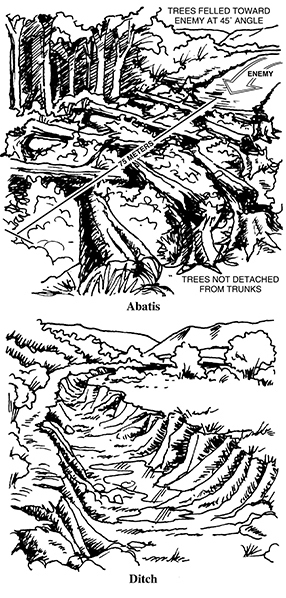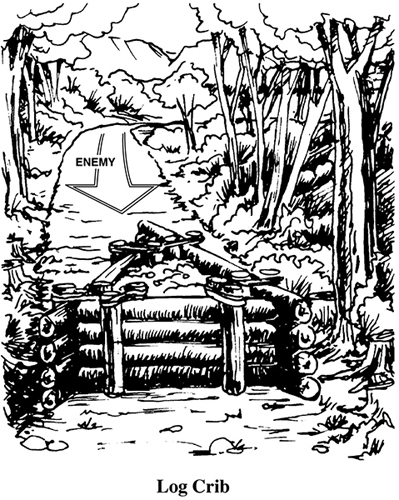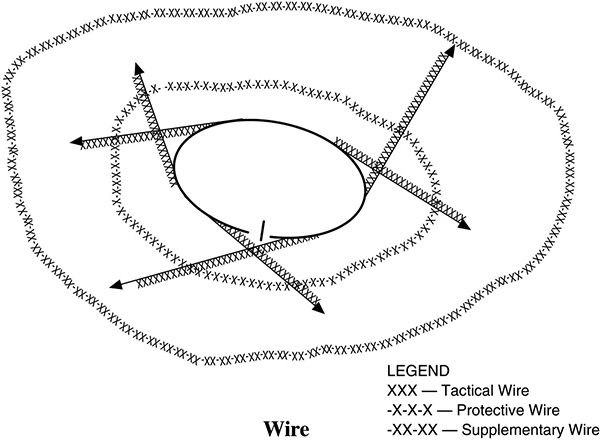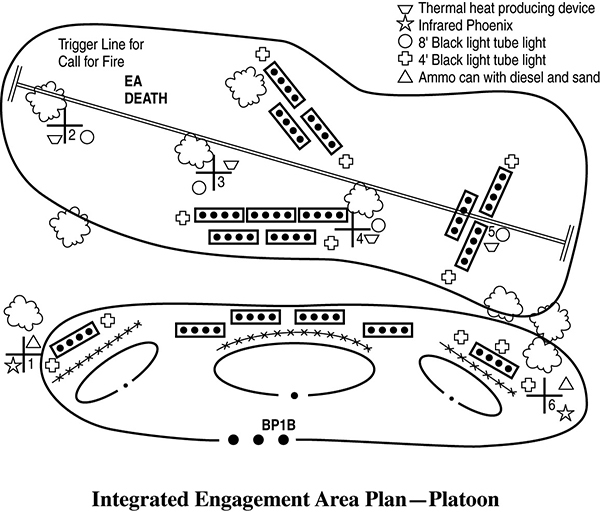Determine Where to Kill the Enemy. As part of his troop-leading procedures, the infantry leader must determine where he will mass combat power on the enemy to accomplish his purpose. This decision is tied to his assessment of how the enemy will fight into the platoon’s EA. Normally this entry point is marked by a prominent reference point (RP) that all platoon elements can engage with their direct-fire weapons. This allows the commander to identify where the platoon will engage enemy forces through the depth of the company EA. In addition, the leader will:
•Select target reference points (TRPs) that match the enemy’s scheme of maneuver, allowing the platoon (or company) to identify fire support adjustment points.
•Identify and record the exact location of each TRP.
•Determine how many weapons systems can focus fires on each TRP to achieve the desired purpose.
•Determine which squad(s) can mass fires on each TRP.
•Begin development of a direct-fire plan that focuses at each TRP.
Note: In marking TRPs, use thermal sights to ensure visibility at the appropriate range under varying conditions, including daylight and limited visibility.
Emplace Weapons Systems
To position weapons effectively, leaders must know the characteristics, capabilities, and limitations of the weapons as well as the effects of terrain and the tactics used by the enemy. Platoon leaders should position weapons where they have protection, where they can avoid detection, and where they can surprise the enemy with accurate, lethal fires. In order to place them, the platoon leader must know where he wants to destroy the enemy and what effect he wants the weapons to achieve. He should also consider:
•Selecting tentative squad defensive positions.
•Conducting a leader’s reconnaissance of the tentative defensive positions.
•Walking the EA to confirm that the selected positions are tactically advantageous.
•Confirming and marking the selected defensive positions.
•Developing a direct-fire plan that accomplishes the platoon’s purpose.
•Ensuring the defensive positions do not conflict with those of adjacent units and are effectively tied in with adjacent positions.
•Selecting primary, alternate, and supplementary fighting positions to achieve the desired effect for each TRP.
•Ensuring the squad leaders position weapons systems so the required numbers of weapons or squads effectively cover each TRP.
•Inspecting all positions.
Note: When possible, select fighting and crew-served weapon positions while moving in the EA. Using the enemy’s perspective enables the platoon leader to assess survivability of the positions.
Plan and Integrate Obstacles
To be successful in the defense, the platoon leader will integrate tactical obstacles with the direct-fire plan, taking into account the intent of each obstacle. Obstacles disrupt, turn, or fix the enemy. A combat platoon must have a clear task and purpose in order to properly emplace a tactical obstacle. Once the tactical obstacle has been emplaced, the platoon leader must report its location and any gaps in the obstacle to the company commander.


There are two types of obstacles: existing and reinforcing. Existing obstacles are those natural or cultural restrictions to movement that are part of the terrain when battle planning begins, such as slopes, gullies, rivers, swamps, trees, or built-up areas. Reinforcing obstacles are those specifically constructed, emplaced, or detonated to tie together, strengthen, and extend existing obstacles. Reinforcing obstacles include road craters, abatis, ditches, log hurdles, cribs, rubble, or wire entanglements.
Wire Obstacles. Wire is classified by its use and location.

Tactical. Tactical wire is sited parallel to and along the friendly side of the final protective line (FPL). It breaks up the enemy attack and holds the enemy where its troops can be killed or wounded by automatic rifle fire, Claymores, hand grenades, and machine-gun fire.
Protective. Protective wire is located to prevent surprise assaults from points close to the defense area. It is close enough for day and night observation but far enough away (40 to 100 meters) to keep the enemy from using hand grenades. Protective wire of adjacent platoons is connected by supplementary wire; this encloses the entire defensive position. Gaps must be provided, however, to allow patrols to exit and enter the position.
Supplementary. Supplementary wire is used to disguise the exact lines of the tactical wire. It prevents the enemy from locating the unit’s perimeter and machine guns by following the wire.
Minefields. Mines are one of the most effective tank destroyers and personnel killers on the battlefield. The infantry platoon most commonly emplaces hasty protective, point, and phony minefields (see Appendix C).
Plan and Integrate Indirect Fires
In planning and integrating indirect fires, the platoon leader must accomplish the following:
•Determine the purpose of fires, if the company commander has not already done so.
•Determine where that purpose will best be achieved, if the company commander has not already done so.
•Establish the observation plan with redundancy for each target. Observers will include the platoon leader as well as members of subordinate elements (such as team leaders) with fire support responsibilities.
•Establish triggers based on enemy movement rates.
•Obtain accurate target locations using survey and navigational equipment.
•Refine target locations to ensure coverage of obstacles.
•Register artillery and mortars and plan final protective fires (FPF).
Also see the “Fires” portion of the coordination checklists on pages 24 and 28–29.

Conduct an Engagement Area Rehearsal
The purpose of rehearsal is to ensure that every leader and every soldier understands the plan and is prepared to cover his assigned areas with direct and indirect fires. The platoon will likely participate in a company level EA rehearsal.
The company commander has several options for conducting a rehearsal, but the combined arms rehearsal produces the most detailed understanding of the plan. One rehearsal technique is to have the platoon sergeant and squads conduct a movement through the EA to depict the attacking enemy force, while the platoon leader and squad leaders rehearse the battle from the platoon defensive positions. The rehearsal should cover:
•Rearward passage of security forces (as required).
•Closure of lanes (as required).
•Use of fire commands, triggers, and/or maximum engagement lines (MELs) to initiate direct and indirect fires.
•Shifting of fires to refocus and redistribute fire effects.
•Disengagement criteria.
•Identification of displacement routes and times.
•Preparation and transmission of critical reports.
•Assessment of the effects of enemy weapons systems.
•Displacement to alternate, supplementary, or subsequent defensive positions.
•Cross-leveling or resupply of Class V items.
•Evacuation of casualties.
Note: When conducting his rehearsal, the platoon leader should coordinate with the company to ensure other units’ rehearsals are not planned for the same time and location and to eliminate the danger of misidentification of friendly forces in the rehearsal area.